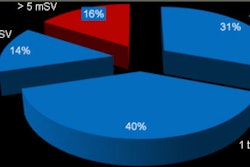Tuesday, November 29 | 3:20 p.m.-3:30 p.m. | SSJ04-03 | Room S503AB
A study by Italian researchers suggests that a single dose of the MRI contrast agent gadobutrol is just as effective as a double dose of gadopentetate dimeglumine in cardiac MR imaging.The study included 20 adult patients scheduled for cardiac late-enhancement MRI, comparing 0.2 mmol/kg of gadopentetate dimeglumine (Magnevist, Bayer HealthCare Pharmaceuticals) with 0.1 mmol/kgof gadobutrol (Gadovist, Bayer).
Late-enhancement images were similar with gadobutrol and gadopentetate dimeglumine in terms of both total volume of myocardium and percentage of myocardial wall involvement, according to the researchers.
They found essentially no difference in the number of segments involved: 138 for gadobutrol, compared with 134 for gadopentetate dimeglumine. Also, there was no statistical difference in measurements of signal-to-noise and contrast-to-noise ratios.
"In this application, we immediately noted that late-enhancement imaging obtained with a single dose of gadobutrol was strictly comparable by visual imaging, and then by statistic analysis, with that obtained with the double dose of the prior conventional contrast agent gadopentetate, probably due to its high relaxivity with a more compact bolus profile," said presenter Dr. Claudio Sallemi, a radiology resident at the San Raffaele Scientific Institute.
As for the clinical benefit, Sallemi and colleagues noted that gadobutrol is associated with a low risk of nephrogenic systemic fibrosis (NSF) and is recommended for cardiac MRI in patients with renal failure.
"The principal quality of gadobutrol that makes it better than gadopentetate is the same extent and distribution of late enhancement and very good image quality with half of the dose, combined with a well-known safety profile," Sallemi said. "This has the clinical potential of decreasing the dose of the contrast and, therefore, the risk for developing nephrogenic systemic fibrosis, without losing any image quality."
The main limitation of this study was its small sample size, Sallemi noted. He and his colleagues plan to continue their work to have a larger number of patients and expanded data to confirm the preliminary findings.



.fFmgij6Hin.png?auto=compress%2Cformat&fit=crop&h=100&q=70&w=100)




.fFmgij6Hin.png?auto=compress%2Cformat&fit=crop&h=167&q=70&w=250)











